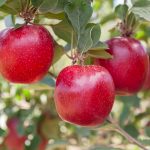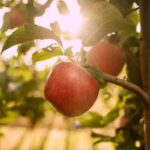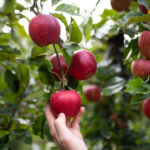Early U.S. apple season an "advantage" with excellent crop

The recent Washington State cherry season was one of the best Steve Reinholt of Oneonta Starr Ranch Growers can remember, and the apple deal just may follow suit. At www.freshfruitportal.com, we catch up with him and two other growers to discuss the apple season ahead, fundamental market trends and some reflection on the "nerve-wracking" ordeal of Mexico's anti-dumping duties during the last campaign which were eventually quashed.
Reinholt describes apples and pears as a "vintage crop" quality-wise this year, with production running about 10 days early; a trend that seems to be the consensus amongst Washington State growers.
"We just came through a cherry season that aside from some rains that happened in a few spots, really the overall quality of the fruit was excellent, as good as I’ve seen in my 30 years," he tells www.freshfruitportal.com.
"And usually apple and pear crops carry on in a similar vein as the earlier cherries do, so we expect this is going to be an excellent year."
And while he agrees the Washington State Tree Fruit Association's (WSTFA) forecast of 15% volume growth might be about right, there is still the possibility it could be greater still.
"We know how many apples are on the trees and that part is fairly easy to figure, but we don’t know how big the fruit is going to get," he says.
"Every size the apple grows up can affect the crop as much as 10%," he says, adding this is likely if the "perfect" weather continues through September.
Tim Evans of Chelan Fresh also gives his thoughts on recent weather and what it could mean for the fruit.
"Washington had a very warm spring post bloom which makes for a very good start to the growing season and fruit is sizing very well," Evans says.
"We have had a cooler summer with much cooler nights overall, which should do well for overall color on apples.
He says it is important that the industry get out of the gate with strong promotions in the fall.
"This is very important in setting the pace for a good season and with exceptional quality coming, it will make a very positive impact in velocity of sales," he says.
"After a smaller overall crop last year, we will see good increases on Honeycrisp, Gala, Fuji and Red Delicious. Pink Lady are up slightly with other club varieties up significantly over last year."
Stemilt Growers has started its season with the Minnieska variety which it markets as Sweetango, while harvesting has also begun with Red Galas.
"Honeycrisp will follow very soon after, and then we’re into some pears, and really by September we pretty much start harvesting every variety that we have," says the company's communications manager Brianna Shales.
She says the early harvest is exciting because Stemilt will be able to bring apples to the marketplace before domestic regional supplies come into play on the East Coast and in Michigan.
"We see it as an advantage. You don’t get to decide when the apples are ready on the tree so being 10 days early really gives us a jumpstart on promotions for that early September timeframe," Shales says.
"And because a lot of crops have been pushed earlier this year, at least on the West Coast, apples are going to take the place that maybe cherries were going to take at the end of the month but because they’re wrapping up early.
"It's a way for retailers to shuffle the shelf space around, given the fact cherries and nectarines have been early."
Shales says one of the biggest challenges at her company is to try and forecast what will be the varieties consumers recognize and value in five years' time, and a lot of that revolves around which cultivars can deliver the so called "Honeycrisp crunch".
"What we’re really seeing a production increase around is Honeycrisp - that’s a major consumer favorite," she says.
"Fuji is trending upward, especially with the variety Aztec which goes to market as Fuji but it’s a high-color Fuji apple that Stemilt’s really been a pioneer in.
"We’re seeing more Pinata which is our signature variety at Stemilt – that’s a variety that’s had great success since it debuted in 2009 and continues to have its sweet spot in the market around the January timeframe."
Pinata was developed at Dresden-Pillnitz, Germany in the 1970s as a cross between Golden Delicious, Cox's Orange Pippin and Duchess of Oldenburg.
"It has a unique flavor – we tout it as the tropical apple because it has that sweet-tart apple you’re used to but then it has a really subtle, tropical, pineapple-like essence," Shales says.
"Looking out ahead, what are the new varieties coming on that are going to attract consumers from a flavor standpoint? Golden Delicious declined - we'll always have those varieties, but they’re not driving demand at this point; what's driving demand are apples like Honeycrisp, Pink Lady, Pinata, Fuji."
Reinholt says Red Delicious are starting to drop down as an overall percentage of the crop, and that they will soon be overtaken by Gala as the leading variety. But the cultivar will still have an important place in the sector's export programs.
"The Red Delicious is one of the varieties we can grow substantially better here in Washington than anyone else can, but it’s becoming increasingly for an export focus rather than domestic," he says.
Export challenges
Shales mentions the export market is a bit slower in embracing the same variety trends as the U.S., especially when it comes to Asia.
"Especially if you look at the China marketplace where we just recently got access to the market and move varieties in, it’ll take a while to develop those flavors.
"India is still going to be a big Red Delicious consumer, and that we don’t see changing right off the bat, but I think slowly over time we can do it like we do in the domestic marketplace - introduce apples to consumers, see how they’re received, and depending on that it dictates whether retailers are going to continue to buy them or now.
"The Mexican market is definitely a growing one for apples, but also for pears - it's a big pear market for us....they're big Golden [Delicious] consumers but you have to get the fruit certified for Mexico."
Her comments are echoed by Evans.
"Mexico continues to be our largest export market for Washington apple growers and we expect a very good season for Gala, Golden and Red Delicious, as well as pears.
But despite its trade prospects, Mexico has not been all rosy for the Washington State apple sector of late. A complaint brought by the Agricultural Union of Fruit Growers of the State of Chihuahua (UNIFRUT) in December, 2014, led to provisional anti-dumping charges in January this year.
Thankfully for the U.S. growers, the measure was revoked in June.
"It’s nerve-wracking honestly. We never want to lose a market," Reinholt says.
"This coming year is going to be slightly smaller than our previous high watermark but we’re only a year away from potentially having a real big crop and we need every single market there is right now.
"Without them [Mexico] it would be a big problem – we were doing everything that was asked of us, providing all the information to our attorneys. Thankfully it worked out and hopefully it’ll be a while before they do it again."
He says these types of actions are scary for growers, bringing with them a lot of uncertainty from a marketing standpoint.
"And we have to start making plans three to six months in advance of where we think we’re going to be moving the crop next year so we can put into place programs with customers worldwide. Having that black cloud over your head is scary."
Around the world we have seen numerous cases of politics spilling over into the produce trade, the most notable being the Russian embargo on sanctioning countries, but more recently there has been speculation that tough Chinese action on Philippine bananas and New Zealand kiwifruit have been politically motivated; the latter has however been denied by New Zealand Prime Minister John Key.
In this kind of environment, U.S. fruit growers cannot afford any more diplomatic spats with major markets, particularly Mexico.
In line with this, we asked Reinholt whether Republican presidential candidate Donald Trump's disparaging comments about Mexican immigrants and the North American Free Trade Agreement (NAFTA) were of concern.
"I think any time there’s a change in the oval office we all get a little nervous and start thinking of the different kinds of scenarios," he says.
"He’s a businessman and I have to assume he’s not going to do something that’s going to be a wholesale catastrophe for any branch of our economy, but however our apple deal here is a pretty small player in the global economy and with any government – be it him or Mrs Clinton – if they do something that irritates another government, they don’t hesitate to slap restrictive customs on different industries.
"For some reason the produce industry is one that gets caught up in that every time."
The Russian embargo has also impacted exports as European growers look to traditional markets held by the U.S. such as the Middle East and the Far East, and the strong U.S. dollar will make the season more challenging as well.
On a more positive note, Reinholt sees great export growth potential in Central and South America in addition to the aformentioned markets of China and India.
"I don’t believe we’ve hit the limit on India either," he says.
Stabilizing factors
There may be uncertainty overseas, but at home there have been two key areas in which the apple sector has been able to become less volatile, according to Reinholt - the processed market and automated processes in packhouses.
"The processed market is growing and I think a lot of that is due to the acceptance of the sliced apple products that are out there – there are various companies doing it," he says, clarifying that Oneonta does not actually process fruit itself.
"That’s having a huge impact on consumption and I think long term that’s going to continue to be the trend as far as semi-processed fruit.
"The good thing about it is that demand is there year round so if you’ve got some fruit that’s maybe not the right size for a domestic or export fresh package, you can still store it and it’ll market later on the sliced programs."
He says the processed deal effectively puts a floor under the fresh market.
"There are a lot of times the slicers are willing to pay good money for quality product and if that price gets above the equivalent for a fresh package, it’s going to hold those other prices up.
With the help of Unitec sorting lines and the use of robots to palletize and stack boxes, packhouse operations have gotten easier for Oneonta. And if the company had not made these changes, the labor situation could get quite difficult.
"Labor seems to be a bit tighter this year in the packinghouse," he says.
"We just finished up our cherry season – we didn’t have problems getting labor in the field as far as harvesting, that went relatively smoothly, but we were short on labor to work on the packinghouses.
"This is a little strange because with all of the new technologies we’re implementing in the operations we need a heck of a lot less people working inside the building than we used to need, and we can’t find enough."
Both Stemilt and Chelan have been using the H-2A program to attract workers to their farms, which has brought some stability.
"That's kind of our way of securing a labor force," says Shales.
"Labor is an issue every single year but that has helped us as a company to ensure we have the crews we need to get fruit picked and throughout the summer the trees thinned.
"That program, though it’s challenging has helped us have a more stable labor force."
Photo: Oneonta Starr Ranch Growers














































